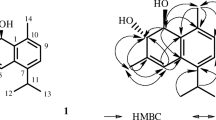Abstract
Four sesquiterpenoids (2, 4, 7, and9) have been isolated and characterized from the termiticidal fraction ofDipterocarpus kerrii resin. The major constituent of this resin is α-gurjunene (1).
Similar content being viewed by others
References
Ashton, P.S. 1982. Dipterocarpaceae.Flora Malesiana, Ser. I, In press.
Bakshi, B.K., Puri, Y.N., andSingh, S. 1967. Natural decay resistance of Indian timbers. I. Introduction and method. II. Resistance of sal (Shorea robusta Gaertn.) and teak (Tectona grandifloris L.f.).Indian for. 93:305–328.
Bhargava, A.K., andChauan, C.S. 1968. Antibacterial activity of some essential oils.Indian J. Pharm. 30:151–152.
Bisset, N.G., Chaveanel, V., Lantz, J.P., andWolff, R.E. 1971. Constituents sesquiterpeniques et triterpeniques des résines du genreShorea.Phytochemistry 10:2451–2463.
Bowyer, R.C., andJefferies, P.R. 1963. Structure of spathulenol.Chem. Ind. 1245–1246.
Brownlee, R.G., andSilverstein, R.M. 1968. A micro-preparative gas Chromatograph and a modified carbon skeleton determinator.Anal. Chem. 38:1131–1135.
Büchi, G., andLowenthal, H.J.E. 1962. Synthesis of epicyclocolorenone and stereochemistry of cyclocolorenone.Proc. Chem. Soc. 280–281.
Büchi, G., Kauffman, J.M., andLowenthal, H.J.E. 1966. Synthesis of 1-epicyclocolorenone and stereochemistry of cyclocolorenone.J. Am. Chem. Soc. 88:3403–3408.
Corbett, R.E., andSpeden, R.N. 1958. The volatile oil ofPseudowintera colorata. Part II. The structure of cyclocolorenone.J. Chem. Soc. 3710–3715.
Corbett, R.E., andYoung, H. 1963. The volatile oil ofPseudowintera colorata IV. Epicyclocolorenone.Aust. J. Chem. 16:250–251.
Devon, T.K., andScott, A.I. 1972. Handbook of Naturally Occurring Compounds, Vol. II, Terpenes. Academic Press, New York.
Doddrell, D.M., andPegg, D.T. 1980. Assignment of proton-decoupled carbon-13 spectra of complex molecules by using polarization transfer spectroscopy. A superior method of offresonance decoupling.J. Am. Chem. Soc. 102:6388–6390.
Elzen, G.W., Williams, H.J., andVinson, S.B. 1984. Isolation and identification of cotton synomones mediating searching behavior by a parasitoid.J. Chem. Ecol. 10:1251–1262.
Hegnauer, R. 1966.Chemotaxonomie der Pflanzen, Vol. IV, pp. 31–42.
Inagaki, F., andAbe, A. 1985. Analysis of1H- and13C-nuclear magnetic resonance spectra of spathulenol by two-dimensional methods.J. Chem. Soc. Perkin Trans. II. 1773–1778.
Marsden, W. 1783. The History of Sumatra. Reprinted 1966, Oxford University Press, Oxford.
Messer, A.C. 1984.Chalicodoma pluto: The world's largest bee rediscovered living communally in termite nests (Hymenoptera: Megachilidae).J. Kans. Entomol. Soc. 57:165–168.
Messer, A.C. 1985. Fresh dipterocarp resins gathered by megachilid bees inhibit growth of pollen-associated fungi.Biotropica 17:175–176.
MoI, L.C. 1980. A new laboratory method for testing the resistance of particle boards to the drywood termiteCryptotermes cynocephalus.Malaysian For. 43:350–355.
Morris, G.A., andFreeman, R. 1979. Enhancement of nuclear magnetic resonance signals by polarization transfer.J. Am. Chem. Soc. 101:760–762.
Ourisson, G. 1966. International Tables of Selected Constants, Vol. 15, Data Relative to Sesqui-terpenoids. Pergamon Press, Oxford.
Palmade, M.,Pesnelle, P.,Streith, J., andOurisson, G. 1963. L'-α-Gurjunene. I. Structure et stereochimie.Bull. Soc. Chim. Fr. 1950–1960.
Sen-Sarma, P.K. 1963. Studies on the natural resistance of timbers to termites. I. Observations on the longevity of the test termiteHeterotermes indicola Wasm. in the saw dust from forty common Indian timbers.Indian For. Bull. (N.S.) Entomol. 220:1–3.
Sen-Sarma, P.K., andChatterjee, P.N. 1968. Studies on the natural resistance of timbers to termite attack. V. Laboratory evaluation of the resistance of Indian wood toMicrocerotermes beesoni Snyder (Termitidae, Amitermitinae).Indian For. 94:694–704.
Shinoda, N., Shiza, M., andNishimura, K. 1970. Constituents of yuzu (Citrusjunos) oil.Agric. Biol. Chem. 34:234–242.
Sootheeswaran, S.,Sultanbawa, M.V.S.,Surendrakumar, S., andBlandon, P. 1983. Polyphenols from a dipterocarp species: Copalliferol a and stemnoporol.J. Chem. Soc. Perkin Trans. I, 699–702.
Streith, J., andOurisson, G. 1963. L'-α-Gurjunene. II. Structure et stereochimie.Bull. Soc. Chim. Fr. 1960–1965.
Sutherland, B. 1978. The suitability of various types of dung and matteras larval breeding media forStomoxys calcitrans L. (Diptera: Muscidae).Onderstepoort I. Vet. Res. 45:241–245.
Torquebiau, E. 1984. Man-made dipterocarp forest in Sumatra.Agrofor. Syst. 2:103–127.
Author information
Authors and Affiliations
Rights and permissions
About this article
Cite this article
Richardson, D.P., Messer, A.C., Greenberg, S. et al. Defensive sesquiterpenoids from a dipterocarp (Dipterocarpus kerrii). J Chem Ecol 15, 731–747 (1989). https://doi.org/10.1007/BF01014715
Received:
Accepted:
Issue Date:
DOI: https://doi.org/10.1007/BF01014715




